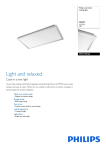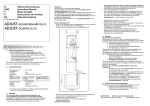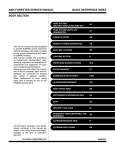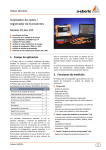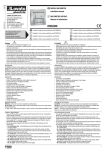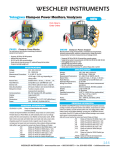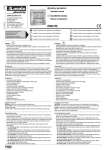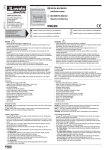Download Operating Instructions
Transcript
Operating Instructions Extensometer Model 200XR and Biaxial Extensometer Model 200XR H.-D. Rudolph GmbH Extensometer Model 200XR February 2010 Page 1 of 11 Contents Page General ...........................................................................3 Description .....................................................................3 Preparations....................................................................4 Measurement ..................................................................8 Maintenance ...................................................................9 Technical Data..............................................................10 List of Standard Lens Units ..........................................11 Note: Model 200XR is electromagnetically compatible according to the European standards for industrial environment. Appendix Wiring Diagram of Model 200XR Calibration Certificate(s) Drawing with Dimensions of Model 200XR Drawing with Dimensions of Gauge Length Adapter 200XR/1-25 Drawing with Dimensions of Gauge Length Adapter 200XR/25-125 Drawing(s) of the Lens Unit(s) H.-D. Rudolph GmbH Extensometer Model 200XR February 2010 Page 2 of 11 General A system 200XR ready for measuring strain consists of: Extensometer 200XR or Biaxial Extensometer 200XR Lens Unit 200XR-... (measuring range in mm, see list of standard lens units)* Power Supply 201R Illuminator for the targets External low-pass filter 50 kHz Optional items to be delivered: Gauge Length Adapter 200XR/1-25 Gauge Length Adapter 200XR/25-125 Three-Axis Table 105 Tripod, heavy version Illuminators with power supply Aluminum transportation case * Special lens units with another measuring range and working distance can be offered as well. Description The electro-optical Extensometer 200XR serves for measuring the motion of two black-andwhite edges (targets) on a sample. The analog output signal is proportional to the strain within the frequency range of 0 – 250 kHz. Viewer and integrated display simplify the performance of the adjustments required for the setup of the instrument; the viewer also allows observing the targets on the sample while their motion is measured. Lens units with different measuring ranges from 1 mm to 500 mm can be mounted to the camera Model 200XR by means of a flange. The calibration of the lens units results in an output voltage ∆l of ±10V for the range of strain. The two measuring axes of the Extensometer 200XR are rectangular to the base plate. The measuring distance l0 is 75 mm. There is the option of delivering Model 200XR with a switch to toggle between the two measuring axes; this allows using the instrument also as Biaxial Extensometer 200XR in order to measure strain in either vertical or horizontal direction; this means that the two measuring axes can be either in right angles (y) or parallel (x) to the base plate. The measuring distance l0 is 75 mm. For the Biaxial Extensometer 200XR the lens units have to be calibrated in both measuring directions, that is to say in x and y. With standard lens units the measuring length l0 is 75 mm. A continuously adjustable gauge length of 1 mm up to 125 mm can be established by means of gauge length adapters mounted to the lens units. With special versions also gauge lengths of more than 125 mm can be measured. H.-D. Rudolph GmbH Extensometer Model 200XR February 2010 Page 3 of 11 Preparations 1) Choose suitable lens unit regarding the measuring range and the measuring distance. Lens unit and Model 200XR must have the same serial number. The motion to be measured on the sample should be at least 40 % of the measuring range. Motions exceeding the measuring range result in wrong measuring values, but won’t damage the instrument. 2) Mount lens unit to Model 200XR. Please make sure that the three cylindrical pins of the extensometer correspond to the boreholes in the flange of the lens unit. The four mounting screws M5 x 16 have to be tightened; the contact pins serve for connecting the components for calibration of the lens unit to the extensometer; they have to be clean and must be resilient over a length of about 5 mm. 3) Connect Power Supply 201XR with Model 200XR by means of the 9-pin Sub-D plug. 4) Connect Power Supply 201XR to the mains. 5) Mount the extensometer stably and free from vibrations for example to the base of a tensile tester. By means of the four tapped holes in the base plate (M6, 10 mm deep) the extensometer can be mounted e.g. on a three-axis table. In addition there is a borehole of 3/8” for mounting it onto a heavy tripod. The bubble level serves for horizontal alignment of the extensometer whose position for operation is arbitrary. The relative motions between the extensometer with lens unit and the sample should be as small as possible, because e.g. in case of lateral motions of the extensometer the targets might get out of the visible range. Also targets that are not exactly rectangular to the direction of measurement and parallel might influence the measuring results. Align the camera to the targets by means of the integrated viewer. The direction of measurement is rectangular to the base plate of the camera. Make sure to keep strictly to the Measuring Distance A as indicated on the lens unit. The Measuring Distance A is the distance between the front edge of the lens unit and the targets. While looking through the viewer high-contrast reproduction of the target within the cross spider must be visible; therefore the operator can achieve individual adjustment by turning the knurled ring. 6) Illuminate both measuring ranges sufficiently. For the illumination we recommend our LED illuminators e.g. our Standard LED Illuminators 60 mm. By means of the two LCD’s on top of the instrument the illumination can be observed in mode LIGHT. The minimum size of each target should be 10% of its measuring range. With standard lens units l0 is 75 mm; in case of another l0 adjustable gauge length adapters such as Model 203XR/25-125 and Model 203XR/1-25 are to be used. Make sure to observe the instructions on the drawings of the gauge length adapters and the system drawings. H.-D. Rudolph GmbH Extensometer Model 200XR February 2010 Page 4 of 11 There are two possibilities of illumination: Arrangement A: ILLUMINATION FROM THE REAR With diffusers attached the illuminators are arranged behind the targets. This arrangement allows using jutted out edges as targets on the sample instead of black-and-white edges. L LENGTH OF LENS A WORKING DISTANCE 2 JUTTED OUT EDGES AS TARGETS RUDOLPH GmbH MODEL 200XR SN 201 UNIFORMLY WHITE ILLUMINATED AREA approx. 100x 20 mm Plastic diffuser FW 102 OPTICAL AXIS RUDOLPH GmbH MODEL 200XR FW 102 EXTENSOMETER MODEL 200XR RUDOLPH GmbH LED ILLUMINATOR 110 mm APERTURE SN 201 TOP VIEW Arrangement B: ILLUMINATION FROM THE FRONT The targets on the sample are illuminated from the front without using a diffuser. There must be two black-and-white edges as measuring targets on the surface, with a measuring distance of l0. Do only use dull colors for marking lines on the surface of a sample. The division between black and white must be straight and rectangular to the direction of measurement. L LENGTH .OF LENS A WORKING .DISTANCE APERTURE RUDOLPH GmbH MODEL 200XR SN 201 F W 102 OPTICAL AXIS RUDOLPH GmbH MODEL 200XR SN 201 2 PAINTED BLACK AND WHITE TARGETS ON SAMPLE F W 102 EXTENSOMETER MODEL 200XR RUDOLPH GmbH H.-D. Rudolph GmbH Extensometer Model 200XR . 90 OX PR AP mm LED ILLUMINATOR 110 mm TOP VIEW February 2010 Page 5 of 11 Note: Polished metal surfaces can change their reflecting qualities during a measurement and therefore may not be suitable when used without targets painted on. 5% 5% MINIMUM SIZE OF TARGET OBSERVED THROUGH THE VIEWER CHANNEL A , B 10% 7) Now switch on Power Supply 201XR and observe both LCD’s on the camera. The extensometer scans the measuring ranges five times per second and displays the distribution of light within the measuring ranges (Channel A and Channel B) via the LCD’s. If the measuring ranges are too bright OVEREXPOSURE is displayed. In this case either the intensity of illumination must be reduced or the diaphragms on the lens unit have to be closed step by step until appropriate illumination is achieved. There is appropriate illumination when the whole line on each display, which represents the distribution of light within the measuring range concerned, is to be seen above the two red spots on the LCD. Mode LIGHT Channel B: Measuring range is overexposed. Mode LIGHT Channel A: Measuring range is not illuminated sufficiently. H.-D. Rudolph GmbH Extensometer Model 200XR February 2010 Page 6 of 11 If neither of the two methods of illumination mentioned above leads to proper illumination there will be also the possibility of increasing the light sensitivity of the camera by means of the knob SENSITIVITY. Mode LIGHT Channel B: The illumination of the measuring range is even and sufficient and can be used for measurement. Mode LIGHT Channel A: The illumination of the measuring range is uneven und cannot be used for measurement. Mode LIGHT Channel B: Black-and-white edge within the measuring range with sufficient contrast Mode LIGHT Channel A: Black-and-white edge within the measuring range without sufficient contrast Strain Measurement on Specimens in a Test Chamber If the temperature of the specimen in the test chamber is between -200°C and +250°C strain measurement can take place by front light. The 200XR measures into the strain through a glass window. The two targets can be illuminated by flexible light guides. If the temperature of the specimen exceeds 250°C strain measurement has to take place by transmitted light; then the specimen itself must have - or must have been provided with - small edges jutting out. There must be a second glass window in the rear of the test chamber. In case the temperature of the specimen is very hot, that is to say up to 3000°C, a UV light source has to be used for illumination. Optical filters will help achieving the contrast between light and dark needed for the measurement. H.-D. Rudolph GmbH Extensometer Model 200XR February 2010 Page 7 of 11 Measurement Now move the black-and-white edges of the object of measurement into the measuring ranges. When pushing the red button MEASURE the extensometer begins to search these targets and follows their motion. The sequence of black/white or white/black for Channel A and Channel B is to be chosen by means of the switch TARGET. If the light path between the lens unit and the targets is interrupted, the extensometer no longer will see the targets and SEARCH will be displayed. The analog output of the channel concerned now shows rapid analog voltage alterations. As soon as the extensometer can see the target again, the electronics immediately adapt themselves to it again and display the correct measuring value. Mode MEASURE Channel B: Target is within the measuring range. Mode MEASURE Channel A: While measuring takes place the light path has become interrupted; Channel A is searching for a target. With LOW PASS – separately for Channel A and Channel B - the bandwidth of the amplifier for the analog output can be adjusted in six steps. It is a first order lag low-pass filter; with the frequency indicated it attenuates a sinusoidal measuring signal by -3dB. Digital oscilloscopes or fast pen recorders can be used for recording the measuring values. In case of slow motions of the targets the Low-Pass Filter 50 kHz (-3dB) delivered with the instrument can be connected with the input of an oscilloscope in order to minimize the high frequency noise level. At the analog output ∆l the differential signals for Channel A and Channel B are available as strain measuring signals. The initial values are to be read on the digital displays; before the strain test begins they can be set for example at 0V by means of the potentiometers and the switches OFFSET. Note: Never do apply external voltage to the analog output A, the analog output B, and ∆l. H.-D. Rudolph GmbH Extensometer Model 200XR February 2010 Page 8 of 11 Maintenance 1) Carefully clean: the surface of the lenses, the optical opening of Channel A and the one of Channel B, the contacts and contact surfaces of the printed circuit boards of the lens unit(s) and on front of the 200XR. 2) Check the operating voltage of the Power Supply 201XR by means of the wiring diagram of the extensometer; the nominal voltage is ±12V,DC. Attention: The instrument may only be opened by trained specialists and with the permission of the H.-D. Rudolph GmbH. 3) Check the operating voltage of the photomultiplier; it must be about -830V,DC when the potentiometer LIGHT SENSITIVITY is in position end stop at the left. By turning the potentiometer LIGHT SENSITIVITY clockwise it may increase until about -1100V,DC. 4) For calibration please send the extensometer together with the lens unit(s) to the manufacturer. H.-D. Rudolph GmbH Extensometer Model 200XR February 2010 Page 9 of 11 Technical Data Measuring Range of Channel A and Channel B Working Distance A Resolution Max. Measuring Velocity Low-Pass Filter Channel A and Channel B Target Search Time of Channel A and Channel B Error of Channel A and Channel B Brightness of Target Measuring Width on the Target Arrangement of the Targets Light Sensitivity Display for the adjustment of Channel A and Channel B Spectral Responsivity Analog Output (BNC) Output Impedance Output Load Operating Voltage of Power Supply Model 201XR Operating Temperature Max. Relative Humidity Maximum Impact Stress Weight Dimensions of Camera 200XR Dimensions of Power Supply 201XR from 1 mm up to 500 mm depending on lens unit from 40 mm up to 10 m depending on lens unit 0.01% of the measuring range measured with a bandwidth of 100Hz vmax = (measuring range of lens in mm) x 83.5 m/s first order lag adjustable in steps Bandwidth (-3dB) Noise (mV ptp)* 250 KHz 25 50 KHz 15 10 KHz 8 2.5 KHz 3** 500 Hz 1.5** 100 Hz 1** < 20µs to the first suitable target within the measuring range ± 0.2% of the measuring range > 500 lux approx. 5% of the measuring range black above white or white above black, adjustable by a switch adjustment by means of a 10-gear potentiometer two dot matrix displays with 120 x 32 pixels ea., illuminated 400 – 700 nm ± 5.000 for the measuring range of Channel A and Channel B ± 10,000 V für úl 50 ohms < 10 mA, short circuit protected against ground 85 – 264 V 47 – 63 Hz approx. 30VA 10 – 50° C 90%, non-condensing < 10g in 3 axes 6 kg without lens unit without lens: (L/H/W) 305 mm x 177 mm x 156 mm (L/H/W) 260 mm x 51 mm x 76 mm * measured with lens unit 200XR-10 (measuring range 10 mm), typical value ** measured with external 50 KHz low-pass filter H.-D. Rudolph GmbH Extensometer Model 200XR February 2010 Page 10 of 11 List of Standard Lens Units Model 200XR1 2 5 10 20 50 100 200 500 Measuring Range in mm for Channel A and Channel B 1 2 5 10 20 50 100 200 500 Working Distance A = approx. mm 120 130 190 250 390 800 1400 2900 6000 Length of Lens Unit approx. mm 550 610 350 210 170 140 120 110 100 Standard lens units have a gauge length l0 of 75 mm. Special lens units with another measuring range and working distance can be offered as well. H.-D. Rudolph GmbH Extensometer Model 200XR February 2010 Page 11 of 11











